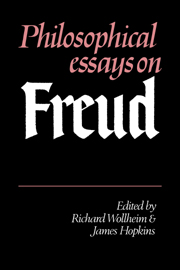Book contents
- Frontmatter
- Contents
- Introduction: philosophy and psychoanalysis
- 1 Conversations on Freud; excerpt from 1932–3 lectures
- 2 Freud, Kepler, and the clinical evidence
- 3 Critical empiricism criticized: the case of Freud
- 4 Freudian commonsense
- 5 Disposition and memory
- 6 On Freud's doctrine of emotions
- 7 The id and the thinking process
- 8 The bodily ego
- 9 Norms and the normal
- 10 On the generation and classification of defence mechanisms
- 11 Models of repression
- 12 Mauvaise foi and the unconscious
- 13 Self-deception and the ‘splitting of the ego’
- 14 Freud's anthropomorphism
- 15 Freud's anatomies of the self
- 16 Motivated irrationality, Freudian theory and cognitive dissonance
- 17 Paradoxes of irrationality
- Works of Freud cited
- Select bibliography
14 - Freud's anthropomorphism
Published online by Cambridge University Press: 01 October 2009
- Frontmatter
- Contents
- Introduction: philosophy and psychoanalysis
- 1 Conversations on Freud; excerpt from 1932–3 lectures
- 2 Freud, Kepler, and the clinical evidence
- 3 Critical empiricism criticized: the case of Freud
- 4 Freudian commonsense
- 5 Disposition and memory
- 6 On Freud's doctrine of emotions
- 7 The id and the thinking process
- 8 The bodily ego
- 9 Norms and the normal
- 10 On the generation and classification of defence mechanisms
- 11 Models of repression
- 12 Mauvaise foi and the unconscious
- 13 Self-deception and the ‘splitting of the ego’
- 14 Freud's anthropomorphism
- 15 Freud's anatomies of the self
- 16 Motivated irrationality, Freudian theory and cognitive dissonance
- 17 Paradoxes of irrationality
- Works of Freud cited
- Select bibliography
Summary
Freud was a materialist, and at an early stage of his psychological inquiries attempted to construct an explicitly physiological psychology based on the interaction of neurons. This attempt, by now well known under the title ‘Project for a scientific psychology’, was abandoned shortly after Freud sent the draft to Fliess in October 1895. And when he learned in 1937 that Marie Bonaparte had unearthed the manuscript, he sought to have it destroyed.
His subsequent theories were of an entirely different character, for they contained only psychological terminology and did not refer explicitly to neuron interaction. Nevertheless, there is a good deal of structural continuity between the earlier and later views, and Freud continued to be convinced that the psychic apparatus which he was investigating and describing in mentalistic terms was in its true nature a physical system – though too little was known about neurophysiology to permit anyone to think about psychology in physical terms. That is why Freud felt it necessary to abandon the line of investigation represented by the Project.
The question therefore arises in what sense it is possible to think about a physical system in mentalistic terms, taken from the vocabulary of experience, perception, desire, etc., without having any idea of the physical significance of those descriptions.
- Type
- Chapter
- Information
- Philosophical Essays on Freud , pp. 228 - 240Publisher: Cambridge University PressPrint publication year: 1982
- 2
- Cited by



